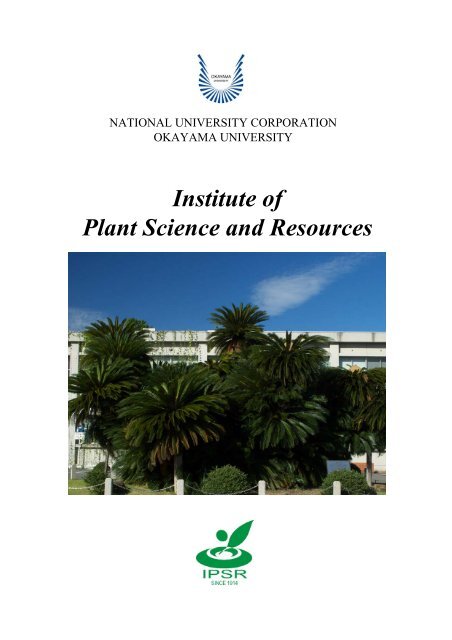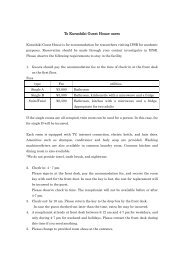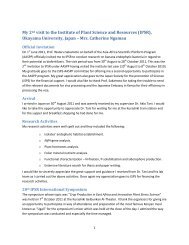Institute of Plant Science and Resources
Institute of Plant Science and Resources
Institute of Plant Science and Resources
You also want an ePaper? Increase the reach of your titles
YUMPU automatically turns print PDFs into web optimized ePapers that Google loves.
NATIONAL UNIVERSITY CORPORATION<br />
OKAYAMA UNIVERSITY<br />
<strong>Institute</strong> <strong>of</strong><br />
<strong>Plant</strong> <strong>Science</strong> <strong>and</strong> <strong>Resources</strong>
CONTENTS<br />
II<br />
II II<br />
III<br />
IV<br />
VV<br />
VI<br />
VII<br />
VIII<br />
IX<br />
XX<br />
History<br />
Buildings<br />
Organization<br />
Number <strong>of</strong> Staff<br />
Graduate School<br />
Library <strong>and</strong> Publications<br />
Public <strong>of</strong>fering <strong>of</strong> joint research <strong>and</strong> major equipment<br />
Research Core for <strong>Plant</strong> Stress <strong>Science</strong><br />
Atmospheric Stress Unit<br />
Group <strong>of</strong> <strong>Plant</strong> Light Acclimation Research<br />
Group <strong>of</strong> Cytomolecular Biochemistry<br />
Group <strong>of</strong> Environmental Response Systems<br />
Soil Stress Unit<br />
Group <strong>of</strong> <strong>Plant</strong> Stress Physiology<br />
Group <strong>of</strong> <strong>Plant</strong> Growth Regulation<br />
Group <strong>of</strong> Molecular <strong>and</strong> Functional <strong>Plant</strong> Biology<br />
Biotic Stress Unit<br />
Group <strong>of</strong> <strong>Plant</strong>-Microbe Interactions<br />
Group <strong>of</strong> <strong>Plant</strong>-Insect Interactions<br />
Barley <strong>and</strong> Wild <strong>Plant</strong> Resource Center<br />
Genetic <strong>Resources</strong> Unit<br />
Group <strong>of</strong> Barley <strong>Resources</strong><br />
Group <strong>of</strong> Genetic <strong>Resources</strong> <strong>and</strong> Functions<br />
Group <strong>of</strong> Wild <strong>Plant</strong> <strong>Science</strong><br />
Applied Genomics Unit<br />
Group <strong>of</strong> Nuclear Genomics<br />
Group <strong>of</strong> Genome Regulation<br />
Group <strong>of</strong> Adaptation to Bioenvironmental<br />
Research Core for Future Crops
II<br />
History<br />
The <strong>Institute</strong> was founded in 1914 as the "Oohara <strong>Institute</strong> for<br />
Agricultural Research" by Magosaburo Oohara, a leading citizen <strong>of</strong><br />
Kurashiki City, with the purpose <strong>of</strong> advancing agricultural sciences.<br />
After the Second World War, the <strong>Institute</strong> became affiliated with the<br />
School <strong>of</strong> Agricultural <strong>Science</strong> <strong>of</strong> Okayama University founded in 1951, <strong>and</strong><br />
became the"<strong>Institute</strong> for Agricultural Biology"under the direct supervision <strong>of</strong><br />
the University in 1953. Initially, five research divisions were organized;<br />
Applied Entomology, Biochemistry, <strong>Plant</strong> Genetics, <strong>Plant</strong> Pathology <strong>and</strong><br />
<strong>Plant</strong> Physiology. Later new divisions were added, Micrometeorology in<br />
1960, Biological Water Quality in 1966 (the name <strong>of</strong> this division was<br />
changed to Water Quality in 1975), Weed <strong>Science</strong> in 1970 <strong>and</strong> the Barley<br />
Germplasm Center in 1979.<br />
The <strong>Institute</strong> has carried out research on bioresources from an array <strong>of</strong><br />
viewpoints for 70 years. The English name <strong>of</strong> the <strong>Institute</strong> was <strong>of</strong>ficially<br />
changed to the "<strong>Institute</strong> for Agricultural <strong>and</strong> Biological <strong>Science</strong>s, Okayama<br />
University" in 1970.<br />
In order to meet the new scientific <strong>and</strong> social dem<strong>and</strong>s, the <strong>Institute</strong> was<br />
reorganized <strong>and</strong> renamed" The Research <strong>Institute</strong> for Bioresources,<br />
Okayama University" in 1988. The new <strong>Institute</strong> was composed <strong>of</strong> three<br />
divisions including nine laboratories, a division for a Foreign Visiting<br />
Pr<strong>of</strong>essor <strong>and</strong> the Barley Germplasm Center. The last division <strong>and</strong> the center<br />
were unified to establish the Barley <strong>and</strong> Wild <strong>Plant</strong> Resource Center in 1997.<br />
Again this institute was reorganized in 2003. The new organization is<br />
composed <strong>of</strong> the Division <strong>of</strong> Functional Biology <strong>and</strong> Genetics, the Division<br />
<strong>of</strong> Environmental Response Analysis, <strong>and</strong> the Barley <strong>and</strong> Wild <strong>Plant</strong><br />
Resource Center.<br />
In 2004, Okayama University along with a number <strong>of</strong> other universities<br />
were restructured <strong>and</strong> realigned under the National University Corporation<br />
system. Since the institute was approved in June, 2009 as a center-<strong>of</strong>excellence<br />
in the fields <strong>of</strong> “plant genetic resources <strong>and</strong> plant stress science”<br />
by the Ministry <strong>of</strong> Education, Culture, Sports, <strong>Science</strong> <strong>and</strong> Technology,<br />
Japan, it was reorganized as the “<strong>Institute</strong> <strong>of</strong> <strong>Plant</strong> <strong>Science</strong> <strong>and</strong> <strong>Resources</strong><br />
(IPSR)” on April 1, 2010, as a joint usage <strong>and</strong> research center for scientists<br />
in Japan, particularly addressing plant stress studies using genetic resources<br />
<strong>of</strong> barley <strong>and</strong> wild plant species.<br />
This institute also contributes to the education <strong>of</strong> students in the Graduate<br />
School <strong>of</strong> Natural <strong>Science</strong> <strong>and</strong> Technology <strong>and</strong> Graduate School <strong>of</strong><br />
Environmental <strong>Science</strong> (Master’s <strong>and</strong> Doctor’s Degree Course) at Okayama<br />
University
II<br />
Building<br />
J<br />
J<br />
I<br />
H<br />
A<br />
G<br />
B1<br />
B2<br />
E<br />
C<br />
F<br />
B3<br />
D<br />
A<br />
J<br />
A<br />
B1 〜 B3<br />
C<br />
D<br />
E<br />
Administration<br />
Laboratory<br />
Barley <strong>and</strong> Wild <strong>Plant</strong> Resource Center<br />
Library<br />
RI Laboratory<br />
F<br />
G<br />
H<br />
I<br />
J<br />
Gene Research Building<br />
Greenhouses<br />
Isolation Greenhouse<br />
Climate Station<br />
Research Fields<br />
Total area 38,007 m 2<br />
Building area 9,144 m 2
III<br />
Organization<br />
Faculty<br />
Meeting<br />
Scientific<br />
Staff Meeting<br />
Unit Leader<br />
meeting<br />
Group Leader Meeting<br />
Committees<br />
Research Core<br />
for <strong>Plant</strong> Stress<br />
<strong>Science</strong><br />
Atmospheric<br />
Stress Unit<br />
Soil Stress<br />
Unit<br />
Group <strong>of</strong> <strong>Plant</strong> Light<br />
Acclimation Research<br />
Group <strong>of</strong> Cytomolecular<br />
Biochemistry<br />
Group <strong>of</strong> Environmental<br />
Response Systems<br />
Group <strong>of</strong> <strong>Plant</strong> Stress<br />
Physiology<br />
Group <strong>of</strong> <strong>Plant</strong> Growth<br />
Regulation<br />
Group <strong>of</strong> Molecular <strong>and</strong><br />
Functional <strong>Plant</strong> Biology<br />
Director<br />
Vice<br />
Director<br />
Biotic Stress<br />
Unit<br />
Group <strong>of</strong> <strong>Plant</strong>-Microbe<br />
Interactions<br />
Group <strong>of</strong> <strong>Plant</strong>-Insect<br />
Interactions<br />
Genetic<br />
<strong>Resources</strong><br />
Unit<br />
Group <strong>of</strong><br />
Barley <strong>Resources</strong><br />
Group <strong>of</strong> Genetic<br />
<strong>Resources</strong> <strong>and</strong> Functions<br />
Advisory<br />
Committee<br />
Joint Research<br />
Promotion Committee<br />
Barley <strong>and</strong> Wild <strong>Plant</strong><br />
Resource Center<br />
Research Core<br />
for Future Crops<br />
Applied<br />
Genomics<br />
Unit<br />
Group <strong>of</strong><br />
Wild <strong>Plant</strong> <strong>Science</strong><br />
Group <strong>of</strong><br />
Nuclear Genomics<br />
Group <strong>of</strong><br />
Genome Regulation<br />
Group <strong>of</strong><br />
Adaptation to<br />
Bioenvironmental<br />
Administration<br />
Division<br />
General Affairs<br />
Technical<br />
Division<br />
Accountant<br />
University<br />
Library<br />
<strong>Institute</strong> <strong>of</strong> <strong>Plant</strong> <strong>Science</strong> <strong>and</strong><br />
<strong>Resources</strong> Branch Library<br />
Library Unit<br />
Joint Research
IV<br />
Number <strong>of</strong> Staff<br />
Full-time Staff<br />
Pr<strong>of</strong>essors<br />
Associate<br />
Pr<strong>of</strong>essors<br />
Assistant<br />
Pr<strong>of</strong>essors<br />
Research<br />
Associate<br />
Technical<br />
Officials<br />
Administration<br />
Officials<br />
Total<br />
10<br />
8<br />
13<br />
1<br />
9<br />
5[1]<br />
46[1]<br />
[ ] Librarian <strong>of</strong> <strong>Institute</strong> <strong>of</strong> <strong>Plant</strong> <strong>Science</strong> <strong>and</strong> <strong>Resources</strong> Branch Library<br />
Part-time Staff<br />
Part-Time<br />
Technical<br />
Assistants<br />
Part-Time<br />
Researchers<br />
Part-Time<br />
Workers<br />
Tota1<br />
11(1)<br />
8<br />
26<br />
45(1)<br />
( ) Woman Tenure-Track<br />
Advisory Committee<br />
Members<br />
outside the<br />
Univ.<br />
Members<br />
at the<br />
Univ.<br />
Takashi Endo<br />
Kazuo Shinozaki<br />
Naoko Nishizawa<br />
Yuichiro Takahashi<br />
Tomonori Shiraishi<br />
Dean, Graduate School <strong>of</strong> Agriculture, Kyoto Univ.<br />
Director, <strong>Plant</strong> <strong>Science</strong> Center, RIKEN<br />
Pr<strong>of</strong>., Research <strong>Institute</strong> for Bioresources <strong>and</strong><br />
Biotechnology, Ishikawa Pref. Univ.<br />
Pr<strong>of</strong>., Graduate School <strong>of</strong> Natural <strong>Science</strong> <strong>and</strong><br />
Technology, Okayama Univ.<br />
Pr<strong>of</strong>., Graduate School <strong>of</strong> Natural <strong>Science</strong> <strong>and</strong><br />
Technology, Okayama Univ.<br />
Joint Research Promotion Committee<br />
Members<br />
outside the<br />
Univ.<br />
Motoyuki Ashikari<br />
Toru Fujiwara<br />
Pr<strong>of</strong>., Bioscience <strong>and</strong> Biotechnology Center, Nagoya Univ.<br />
Pr<strong>of</strong>., Biotechnology Research Center, Tokyo Univ.
V<br />
Education at Graduate School <strong>of</strong><br />
Natural <strong>Science</strong> <strong>and</strong> Technology<br />
Master’s course<br />
Graduate School<br />
Natural<br />
<strong>Science</strong> <strong>and</strong><br />
Technology<br />
Division<br />
<strong>Science</strong> for<br />
Bioresources<br />
Department<br />
<strong>Plant</strong> Stress <strong>Science</strong><br />
Doctor’s course<br />
Graduate School<br />
Natural<br />
<strong>Science</strong> <strong>and</strong><br />
Technology<br />
Division<br />
Bioscience<br />
Department<br />
<strong>Plant</strong> Stress <strong>Science</strong><br />
Number <strong>of</strong> students<br />
2009 2010 2011<br />
New students<br />
(from outside the Okayama Univ.)<br />
<br />
<br />
<br />
Master’s<br />
course<br />
Total students<br />
<br />
<br />
<br />
Persons that received a degree<br />
<br />
<br />
<br />
New students<br />
(entered at Oct.)<br />
<br />
<br />
<br />
Doctor’s<br />
course<br />
Total students<br />
<br />
<br />
<br />
Persons that received a degree<br />
(by submitting a thesis)<br />
<br />
<br />
<br />
Total<br />
Total students
VI<br />
Library <strong>and</strong> Publications<br />
<strong>Institute</strong> <strong>of</strong> <strong>Plant</strong> <strong>Science</strong> <strong>and</strong> <strong>Resources</strong><br />
Branch Library, Okayama University<br />
The <strong>Institute</strong> library was established in 1921, <strong>and</strong> is recognized as one <strong>of</strong> the<br />
best agricultural <strong>and</strong> biological libraries in Japan, with an extensive selection<br />
<strong>of</strong> scientific periodicals as well as rare <strong>and</strong> valuable books.<br />
These materials have been available to the public since its establishment,<br />
<strong>and</strong> have been consulted by researchers from all over Japan. Some <strong>of</strong> special<br />
collections are exhibited on the occasion <strong>of</strong> permanent or special exhibition.<br />
Library materials<br />
Total number<br />
<strong>of</strong> books<br />
Total number<br />
<strong>of</strong> periodicals<br />
184,015 (92,871 Japanese <strong>and</strong> 91,144 foreign)<br />
12,085 (7,457 Japanese <strong>and</strong> 4,628 foreign<br />
Special collections<br />
Pfeffer’s collection<br />
Oohara’s collection<br />
<strong>of</strong> Chinese books<br />
Oohara’s collection<br />
<strong>of</strong> Japanese<br />
agricultural books<br />
11,730 volumes relating to botany collected by Dr. W. Pfeffer(1845-1920),<br />
pr<strong>of</strong>essor <strong>of</strong> Leipzig University. Pflanzenphysiologie (Pfeffer, W.) etc.<br />
4,720 volumes relating to early Chinese agriculture<br />
2,576 volumes relating to Japanese agriculture<br />
<strong>and</strong> wild plants, issued during the Edo <strong>and</strong> Meiji era.<br />
Pflanzenphysiologie (Pfeffer, W.)<br />
Publications<br />
Bulletin <strong>of</strong> the <strong>Institute</strong> <strong>of</strong> <strong>Plant</strong> <strong>Science</strong> <strong>and</strong> <strong>Resources</strong>, Okayama University, issued once or<br />
twice a year since 1992.<br />
<br />
The Konyo-manroku (An essay relating to<br />
Japanese agriculture written by Konyo Aoki )
VII<br />
Public <strong>of</strong>fering <strong>of</strong> joint research<br />
<strong>and</strong> major equipment<br />
Public <strong>of</strong>fering <strong>of</strong> collaborative research<br />
<strong>Institute</strong> <strong>of</strong> <strong>Plant</strong> <strong>Science</strong> <strong>and</strong> <strong>Resources</strong> (IPSR) publicly <strong>of</strong>fers<br />
opportunities for joint research with outside researchers. After evaluation by<br />
the Joint Research Promotion Committee <strong>and</strong> the Steering Committee,<br />
researchers with selected proposals can perform joint research at the institute.<br />
All studies are conducted in conformity with the rules <strong>of</strong> the institute <strong>and</strong> under<br />
a collaboration agreement. A public <strong>of</strong>fering <strong>of</strong> collaborative research is made<br />
every year. The deadline is the end <strong>of</strong> February. For more details, please check<br />
our homepage http://www.rib.okayama-u.ac.jp/index-j.html<br />
Major equipment<br />
The institute <strong>of</strong>fers research facilities <strong>and</strong> equipment for collaborators <strong>of</strong><br />
selected proposals. Major equipment is as listed below.<br />
Energy-saving growth system for transgenic plants<br />
TEM<br />
SEM<br />
DNA sequencer<br />
DNA microarray scanner<br />
ICPMS<br />
MALDITOF/MS/MS
Diagrammatic images <strong>of</strong> the institute<br />
Applied<br />
genomics<br />
Genetic engineering<br />
Photosynthesis<br />
Oxidative stress<br />
Research Core for<br />
<strong>Plant</strong> Stress Scinece<br />
Mutation lines<br />
Drought<br />
stress<br />
Atmospheric<br />
stress<br />
<strong>Plant</strong> hormone<br />
International<br />
Applied Research<br />
Insect pest<br />
<strong>Plant</strong> virus, Pathogen<br />
Biotic<br />
stress<br />
Barley<br />
resources<br />
Genetic<br />
resources<br />
Wild plant<br />
resources<br />
Micro<br />
organism<br />
Nutrient<br />
absorption<br />
P<br />
Fe<br />
K<br />
H2O<br />
N<br />
Al<br />
Cd<br />
Soil<br />
stress<br />
Toxic ions<br />
Heavy metals
VIII<br />
Research Core for <strong>Plant</strong> Stress <strong>Science</strong><br />
<strong>Plant</strong> stresses are classified into three major factors as described below. Research units<br />
corresponding to respective stress factors carry out collaborative studies. In each unit,<br />
plant stress responses <strong>and</strong> plant interactions with other organisms are studied using<br />
various approaches <strong>of</strong> physiology, biochemistry, pathology, <strong>and</strong> genetics. Barley <strong>and</strong> wild<br />
plant germplasm collected at the institute will be used effectively to develop stresstolerant<br />
crop plants.<br />
Atmospheric Stress Unit<br />
Under atmospheric environments, fluctuations <strong>of</strong> light intensity, temperature, or<br />
humidity can significantly reduce plant growth <strong>and</strong> ultimately affect the crop yield. To<br />
acclimate to such atmospheric stresses, plants have evolved various ways by which<br />
growth defects can be minimized. The atmospheric Stress Research Unit specifically<br />
examines light stress on photosynthetic apparatus in chloroplasts, response to oxidative<br />
stress caused by reactive oxygen species, <strong>and</strong> roles <strong>of</strong> a phytohormone––abscisic acid––<br />
during drought, <strong>and</strong> aim at underst<strong>and</strong>ing the mechanism(s) that enable plants to tolerate<br />
atmospheric stresses at the molecular level. Combined with the use <strong>of</strong> available genetic<br />
resources, our research will facilitate engineering <strong>of</strong> crops that are acclimated to the<br />
atmospheric stresses.<br />
Soil Stress Unit<br />
Problem soils including acid, alkaline, salt <strong>and</strong> heavy-metal contaminated soils<br />
comprise approximately 70% <strong>of</strong> world’s arable soils. Because <strong>of</strong> deficiency <strong>and</strong>/or excess<br />
<strong>of</strong> minerals, the productivity <strong>and</strong> quality <strong>of</strong> crops on these soils are low. Drought<br />
(shortage <strong>of</strong> soil water) is also a major limiting factor for crop production. It is a key to<br />
enhancing crop productivity <strong>and</strong> to improving crop product safety on problem soils to<br />
solve future shortage problems related to foods <strong>and</strong> fuels. In this unit, we specifically<br />
examine the response <strong>and</strong> tolerance mechanisms <strong>of</strong> plants to problem soil stresses such as<br />
drought, salt, aluminum toxicity, iron deficiency, heavy metals, etc. Our goal is to breed<br />
crops with increased productivity <strong>and</strong> safety on problem soils.<br />
Biotic Stress Unit<br />
<strong>Plant</strong>s are exposed to various biotic stresses in the environment. They are exemplified<br />
by infectious pathogens such as viruses, bacteria <strong>and</strong> fungi, <strong>and</strong> destructive insects. By<br />
contrast, numerous microorganisms support the healthy growth <strong>of</strong> plants, e.g., those<br />
infecting plant pathogens to attenuate their virulence, soil-borne organisms that are<br />
mutualistic to plants, <strong>and</strong> beneficial microorganisms residing on the aerial parts <strong>of</strong> plants.<br />
The ultimate goal <strong>of</strong> this unit is to achieve “Healthy <strong>Plant</strong> Growth.” To attain this goal,<br />
we study plant responses to organisms that are influential to plant growth; we also study<br />
the molecular mechanisms <strong>of</strong> their effects, which enhances a better underst<strong>and</strong>ing <strong>of</strong> the<br />
dynamic interactions that occur among organisms affecting plants <strong>and</strong> those that occur<br />
between plants <strong>and</strong> organisms.
Atmospheric Stress Unit<br />
Group <strong>of</strong> <strong>Plant</strong> Light Acclimation Research<br />
Pr<strong>of</strong>essor<br />
Assistant Pr<strong>of</strong>essor<br />
Wataru Sakamoto<br />
Ryo Matsushima<br />
Our group studies plant adaptation to light environment. To this end, we specifically<br />
examine chloroplasts. Photosynthetic apparatuses in chloroplasts are constantly damaged<br />
by excess light energy. Therefore, it is important to underst<strong>and</strong> mechanisms(s) for plants<br />
to acclimate to strong light. Chloroplast development is a complex process that occurs<br />
during plant growth. We employ various approaches to investigate <strong>and</strong> engineer important<br />
factors affecting chloroplast development.<br />
1. Damage <strong>and</strong> repair <strong>of</strong> photosynthetic<br />
complexes<br />
Photosynthetic protein complexes in<br />
thylakoid membranes <strong>of</strong> chloroplasts are<br />
prone to receive oxidative damage.<br />
Therefore, they develop a sophisticated<br />
repair system by which photodamage is<br />
targeted to Photosystem II. We study<br />
critical factors such as proteases involved<br />
in this repair system.<br />
Measurement <strong>of</strong> photosynthetic activity<br />
2. Studies <strong>of</strong> signals/factors controlling<br />
plastid development <strong>and</strong> multi-function<br />
Proplastid (precursor <strong>of</strong> plastids) can<br />
differentiate into plastids <strong>of</strong> various types<br />
such as chloroplasts <strong>and</strong> amyloplasts. Our<br />
molecular genetic studies attempt to<br />
identify signals/factors that control plastid<br />
development.<br />
Life cycle <strong>of</strong> plastids<br />
3. Continuity <strong>and</strong> genetic engineering<br />
<strong>of</strong> plastid genome<br />
Plastids originate from cyanobacterial<br />
endosymbiosis <strong>and</strong> carry their own<br />
genome. Our studies specifically examine<br />
the inheritance mode <strong>of</strong> plastid DNAs<br />
(maternal inheritance) <strong>and</strong> on genetically<br />
engineering plastid genomes, which can<br />
provide a useful strategy for foreign gene<br />
expression in plants.<br />
Amyloplast-related rice mutants<br />
Microspore<br />
Mature pollen<br />
Organellar DNA degradation<br />
during pollen development
Atmospheric Stress Unit<br />
Group <strong>of</strong> Cytomolecular Biochemistry<br />
Associate Pr<strong>of</strong>essor Haruyoshi Konno<br />
Associate Pr<strong>of</strong>essor Manabu Sugimoto<br />
<strong>Plant</strong>s are sensitive to various environmental stimuli. They respond to physical,<br />
chemical, <strong>and</strong> biological stress factors. Consequently, plants can undergo changes in their<br />
development, morphology, <strong>and</strong> physiology during their life cycle.<br />
We have elucidated the physiological function <strong>and</strong> stress tolerance mechanisms <strong>of</strong><br />
plant cells under stress conditions using biochemical techniques.<br />
Current research includes<br />
1) Functions <strong>of</strong> genes <strong>and</strong> proteins expressed in plants exposed to a space environment<br />
<strong>and</strong> oxidative stress, <strong>and</strong> their application to the development <strong>of</strong> stress-tolerant plants.<br />
2) Mechanisms <strong>of</strong> metal tolerance in wild plants.<br />
3) Characteristics <strong>of</strong> plant cell walls <strong>and</strong> their degrading enzymes.<br />
a<br />
b<br />
CNASA<br />
Two-dimensional gel pr<strong>of</strong>iles <strong>of</strong> proteins extracted from roots<br />
<strong>of</strong> salt-tolerant barley (a) <strong>and</strong> salt-sensitive barley (b). Specific<br />
protein spots located in salt-tolerant barley (arrows).<br />
CIBMP<br />
Fern (L) <strong>and</strong> moss (R) grown in a copper-rich medium.<br />
Gene expression <strong>of</strong> plants grown in the<br />
plant growth chamber onboard Russian<br />
segment <strong>of</strong> the International Space Station.
Atmospheric Stress Unit<br />
Group <strong>of</strong> Environmental Response Systems<br />
Pr<strong>of</strong>essor Takashi Hirayama<br />
Assistant pr<strong>of</strong>essor Izumi Mori<br />
As sessile organism, plants cannot move. Therefore, plants must sense <strong>and</strong> adapt to<br />
environmental changes. They are presumed to have unique mechanisms that are used for<br />
environmental stress responses. Our group has been studying the mechanisms <strong>of</strong><br />
responses to abiotic stresses such as drought stress <strong>and</strong> to phytohormones involved in<br />
these processes using molecular genetics, molecular biology, <strong>and</strong> cell physiology. Our<br />
goal is to underst<strong>and</strong> the stress-sensing mechanisms <strong>and</strong> interactions between various<br />
hormonal responses.<br />
A phytohormone, abscisic acid (ABA), is deeply involved in abiotic stress responses <strong>of</strong><br />
plants. Several plants with abnormal responses to abscisic acid (ABA) have been<br />
isolated from the model plant Arabidopsis <strong>and</strong> then analyzed. Through molecular genetic<br />
analysis <strong>of</strong> these mutants <strong>and</strong> biochemical characterization <strong>of</strong> the gene products, we<br />
established a major ABA signaling pathway comprising PYR1 type ABA receptor, PP2C,<br />
<strong>and</strong> SnRK2. We are also studying interactions between ABA <strong>and</strong> other plant hormones.<br />
2D imbibed seed<br />
ProAHG1:GUS<br />
ProAHG3:GUS<br />
wild type<br />
ahg1-1<br />
ahg3-1<br />
double<br />
0.1 µM ABA, 5 day<br />
PP2C mutants, ahg1 & ahg3<br />
Genetic impairment in two type 2C protein<br />
phosphatases (PP2C), AHG1 <strong>and</strong> AHG3, caused<br />
strong ABA hypersensitivity in germination.<br />
Upper panel, expression pattern in seeds; lower,<br />
ABA sensitivity in germination.<br />
Novel mutant, ahg2-1<br />
ahg2-1 exhibits hypersensitivity to both<br />
ABA <strong>and</strong> salicylic acid (SA), which are<br />
believed to function in a mutually<br />
antagonistic fashion. Analyzing this mutant<br />
is expected to provide new clues to dissect<br />
the complex interaction between these two<br />
hormones. AHG2 encodes enzymes<br />
involved in RNA degradation indicating<br />
RNA metabolisms somehow take part in<br />
the hormone responses <strong>and</strong> interactions.<br />
0.3 µM<br />
ABA<br />
0 µM<br />
ABA<br />
<br />
Model <strong>of</strong> the major ABA signaling pathway<br />
The PYR1-type ABA receptor binds to PP2Cs<br />
<strong>and</strong> inhibits their activity in the presence <strong>of</strong> ABA.<br />
It subsequently induces activation <strong>of</strong> SnRK2<br />
protein kinases that activate a series <strong>of</strong> ABA<br />
responsive mechanisms, such as transcription<br />
factors <strong>and</strong> transporters.<br />
wild type<br />
ahg2<br />
ABA sensitivity<br />
at germination<br />
ABA content ng/mg FW<br />
60<br />
50<br />
40<br />
30<br />
20<br />
10<br />
0<br />
WT ahg2<br />
SA content µg/mg FW<br />
8<br />
7<br />
6<br />
5<br />
4<br />
3<br />
2<br />
1<br />
0<br />
WT ahg2<br />
Endogenous hormone levels
Soil Stress Unit<br />
Group <strong>of</strong> <strong>Plant</strong> Stress Physiology<br />
Pr<strong>of</strong>essor<br />
Jian Feng Ma<br />
Assistant Pr<strong>of</strong>essor Naoki Yamaji<br />
Crop production on 70% <strong>of</strong> the world’s soil is limited by mineral stresses, which include<br />
deficiency <strong>of</strong> essential elements <strong>and</strong>/or excess <strong>of</strong> essential <strong>and</strong> other elements. To improve crop<br />
production on these problem soils, our group specifically examines the response <strong>of</strong> plants to<br />
mineral stresses, especially for underst<strong>and</strong>ing the tolerance mechanisms from the gene to the whole<br />
plant level.<br />
Tolerance mechanisms <strong>of</strong> Al-toxicity<br />
In acidic soil, toxicity <strong>of</strong> aluminum ion<br />
(Al 3+ ) is the major factor limiting crop<br />
production. However, some species have<br />
Beneficial effects <strong>of</strong> silicon<br />
In fact, Si is the only element which alleviates<br />
multiple plant stresses including diseases, pests,<br />
<strong>and</strong> lodging. Rice is a typical Si-accumulating plant.<br />
It requires great amount <strong>of</strong> Si for healthy growth.<br />
+Si<br />
–Si<br />
Wild type<br />
low-Si<br />
mutant<br />
(lsi1)<br />
Suppression <strong>of</strong> leaf blast Effect on grain discoloration<br />
Molecular mechanism <strong>of</strong> rice Si uptake<br />
The Si influx <strong>and</strong> efflux transporters Lsi1 <strong>and</strong><br />
Lsi2 are localized<br />
at opposite sides<br />
<strong>of</strong> the root<br />
exodermis <strong>and</strong><br />
endodermis.<br />
The Si transported<br />
into the cells by<br />
Lsi1 is exported<br />
by Lsi2 to reach<br />
the stele.<br />
evolved various strategies<br />
to detoxify Al.<br />
The Al-tolerant cultivars <strong>of</strong><br />
barley secrete citrate from<br />
the roots, which is mediated<br />
by an Al-activated citrate<br />
transporter HvAACT1.<br />
pH<br />
5.0 4.5<br />
HvAACT1<br />
Tolerance mechanism <strong>of</strong> Fe-deficiency stress<br />
Gramineous plants acquire insoluble soil iron by<br />
secreting mugineic acids (MAs) as an iron<br />
chelator from the roots. Barley has a specific<br />
transporter, HvYS1, for Fe(III)-MA complex at<br />
the root epidermis.<br />
Rhizosphere<br />
Root<br />
Insoluble<br />
Fe(III)<br />
MA<br />
Fe(III)-MA<br />
X<br />
YS<br />
1<br />
R 1<br />
HN<br />
MA<br />
COOH<br />
R 2<br />
COOH<br />
NH<br />
Fe(III)-MA<br />
COOH<br />
OH<br />
HvYS1<br />
Metal-accumulating plants<br />
<strong>Plant</strong> growth is usually inhibited by metals at<br />
high concentrations. However, a few plant<br />
species are known to accumulate metals at<br />
high concentrations without exhibiting<br />
symptoms <strong>of</strong> toxicity. Hydrangea (left) <strong>and</strong><br />
Thlaspi caerulescens (right) respectively<br />
represent two examples <strong>of</strong> Al-accumulators<br />
<strong>and</strong> Cd <strong>and</strong> Zn hyperaccumulators,<br />
respectively. They detoxify metals internally<br />
by forming non-phytotoxic complexes with<br />
lig<strong>and</strong>s <strong>and</strong>/or sequestering <strong>of</strong> the metals to<br />
the vacuoles.
Soil Stress Unit<br />
Group <strong>of</strong> <strong>Plant</strong> Growth Regulation<br />
Pr<strong>of</strong>essor Yoko Yamamoto<br />
Assistant Pr<strong>of</strong>essor Takayuki Sasaki<br />
Aluminum (Al) ion is a major limiting factor <strong>of</strong> crop growth in acidic soils. We study<br />
both Al toxicity <strong>and</strong> tolerance mechanisms. Major toxic symptoms are cell elongation<br />
inhibition <strong>and</strong> cell death. The mechanisms <strong>of</strong> these symptoms are analyzed, particularly<br />
addressing sugar uptake <strong>and</strong> sugar metabolisms now. Furthermore, the effect <strong>of</strong> Al stress<br />
on photosynthesis in shoot parts is analyzed to elucidate how stress at root parts will be<br />
recognized <strong>and</strong> overcome on a whole plant level. On the other h<strong>and</strong>, we isolated wheat<br />
Al-tolerant gene (also acid-soil-tolerant gene), ALMT1, which encodes Al-activated<br />
malate transporter. Now, the expression <strong>and</strong> functional analyses (e.g. activation<br />
mechanism by Al) are studied using molecular-biological <strong>and</strong> electrophysiological<br />
techniques. Furthermore, because the ALMT gene family is specific to plants, the<br />
functional diversity <strong>of</strong> the ALMT1 homologues is studied.<br />
Sugar<br />
Water<br />
Al<br />
ROS<br />
Acid soil<br />
(Andisol)<br />
Neutral<br />
Fig. 1 Al symptom<br />
in acidic soil<br />
Al-tolerant wheat<br />
Fig. 2 Reactive oxygen<br />
species (ROS) induced by Al<br />
in pea roots<br />
Al ion triggers ROS production at<br />
the root elongation zone (shown as<br />
orange by DHE staining; right,<br />
control root; left, Al-treated root).<br />
Yamamoto et al. (2002, 2003)<br />
Al-sensitive wheat<br />
Fig. 3 Mechanism <strong>of</strong> cell<br />
elongation inhibition by Al<br />
In tobacco cells, Al ion inhibits<br />
sugar uptake, which is apparently a<br />
direct cause <strong>of</strong> the inhibition <strong>of</strong><br />
water uptake (namely, cell<br />
elongation inhibition). Then, ROS<br />
production is induced, which<br />
engenders cell death. Abdel-Basset<br />
et al. (2010) et al. (2010)<br />
Repeated upstream<br />
ALMT1 gene<br />
Nucleus<br />
Non repeat upstream<br />
ALMT1 gene<br />
Anion<br />
AtALMT12<br />
Large amount <strong>of</strong><br />
ALMT1 mRNA<br />
Large amount <strong>of</strong> ALMT1protein<br />
A little ALMT1 mRNA<br />
A little ALMT1 protein<br />
Closing<br />
Al 3+ Al 3+ Al 3+ Al 3+<br />
Al 3+ Al 3+<br />
malate 2-<br />
malate 2-<br />
Al 3+<br />
Al 3+ malate 2-<br />
Al 3+ malate 2-<br />
Protect from Al<br />
Al 3+ malate 2-<br />
Al 3+ malate 2-<br />
malate 2-<br />
Al 3+ Al 3+<br />
Al injury<br />
Fig. 4 Relationship between upstream sequence<br />
<strong>of</strong> ALMT1 <strong>and</strong> Al tolerance in wheat<br />
The number <strong>of</strong> repeats in the ALMT1 upstream region is<br />
correlated positively with the levels <strong>of</strong> ALMT1 expression <strong>and</strong><br />
Al tolerance. This finding enabled the development <strong>of</strong><br />
molecular markers based on the Al tolerance gene <strong>of</strong> wheat.<br />
Sasaki et al. (2006), Raman et al. (2008)<br />
Fig. 5 Guard-cell AtALMT12<br />
AtALMT12 anion transporter is<br />
required for stomatal closure in<br />
Arabidopsis. It is important to know<br />
the functional diversity <strong>of</strong> the plant<br />
specific ALMT-type transporter<br />
family. Sasaki, Mori, Furuichi et al.<br />
(2010)
Soil Stress Unit<br />
Group <strong>of</strong> Molecular <strong>and</strong> Functional<br />
<strong>Plant</strong> Biology<br />
Associate Pr<strong>of</strong>essor Maki Katsuhara<br />
Assistant Pr<strong>of</strong>essor Mineo Shibasaka<br />
In this laboratory, we study response mechanisms <strong>of</strong> plants against drought <strong>and</strong> salt<br />
stress environments, especially the molecular functions <strong>of</strong> plant cell <strong>and</strong> biomembranes.<br />
At present, the following research is underway:<br />
Structure <strong>and</strong> function <strong>of</strong> water channels (aquaporins)<br />
Regulatory mechanisms <strong>of</strong> water transport activity in aquaporins<br />
Aquaporins permeating molecules other than water (CO 2 <strong>and</strong> H 2 O 2 )<br />
<strong>Plant</strong> molecular <strong>and</strong> cell physiological studies <strong>of</strong> the stress tolerance mechanism<br />
Relation between stress response <strong>and</strong> controlling expression <strong>of</strong> aquaporins <strong>and</strong><br />
water transport activities in roots<br />
Functional analysis <strong>of</strong> membrane transport proteins against salt stress<br />
Stress-induced programmed cell death<br />
New technology for ro<strong>of</strong>-top greening with high drought-stress tolerance<br />
Goals <strong>of</strong> our research are:<br />
Increase <strong>of</strong> crop production with plants growing well under stressful environments<br />
Promotion <strong>of</strong> environmental greening <strong>and</strong> controlling global water crisis<br />
We use the following techniques <strong>and</strong> methods as well as general physiological <strong>and</strong><br />
molecular biological methods:<br />
Measurement <strong>of</strong> root functions (water permeability, ion transport)/ Xenopus oocyte<br />
expression system/ Electrophysiological measurements/Tracer experiments/<br />
Complementary transgenic experiment with yeast mutants/Bioinformatics<br />
Xenopus<br />
oocyte<br />
Micropipette<br />
cRNA<br />
Aquaporin H 2 O<br />
(A) (B) (C)<br />
Transport proteins in<br />
the plant cell.<br />
Xenopus oocyte expression system.<br />
The cRNA synthesized with template<br />
cDNA is injected into a Xenopus<br />
oocyte (A). Protein is composed in the<br />
oocyte cell <strong>and</strong> membrane protein is<br />
incorporated in a plasma-membrane<br />
(B). With hypotonic conditions, water<br />
flows into the oocyte. The cell starts<br />
swelling if the expressed protein has a<br />
water transport activity (C).<br />
Ro<strong>of</strong>-top greening with a thinlayer/fixed<br />
soil system (top)<br />
<strong>and</strong> a wetl<strong>and</strong> type (bottom)
Biotic Stress Unit<br />
Group <strong>of</strong> <strong>Plant</strong>-Microbe Interactions<br />
Pr<strong>of</strong>essor Nobuhiro Suzuki<br />
Assistant Pr<strong>of</strong>essor Hideki Kondo<br />
Assistant Pr<strong>of</strong>essor Akio Tani<br />
<strong>Plant</strong> growth is influenced by various microorganisms including beneficial <strong>and</strong><br />
harmful ones. Among them are plant-infecting viruses that severely damage crops, <strong>and</strong><br />
mycoviruses infecting phytopathogenic fungi that serve as biocontrol (virocontrol)<br />
agents. In addition, an increasing number <strong>of</strong> plant-mutualistic bacteria <strong>and</strong> fungi that<br />
enhance plant growth <strong>and</strong> stress tolerance have been found. This group is mainly<br />
engaged in the three projects explained below.<br />
1 plant/pathogenic virus/vector<br />
Three systems––orchids/viruses/Brevipalpus<br />
californicus, Arabidopsis thaliana/viruses,<br />
<strong>and</strong> Triticeae/viruses––are the subjects <strong>of</strong><br />
exploration at the molecular, cellular, <strong>and</strong><br />
individual levels <strong>of</strong> pathogenesis, replication,<br />
<strong>and</strong> vector transmissibility <strong>of</strong> plant viruses,<br />
<strong>and</strong> plant responses to virus infections. <strong>Plant</strong><br />
virus-based vectors are also developed.<br />
A. OFV: symptoms in an orchard, the vector Brevipalpus<br />
californicus <strong>and</strong> virus particles<br />
A<br />
EP155<br />
(virus-free)<br />
B<br />
B<br />
CHV1-EP713<br />
(wildtype virus)<br />
2 plant/pathogenic fungus/virus<br />
Using two combinations, chestnut/chestnut blight<br />
fungus/mycoviruses <strong>and</strong> fruit tree/root rot<br />
fungi/mycoviruses, viral replication <strong>and</strong> symptom<br />
expression were investigated at the molecular <strong>and</strong><br />
cellular levels for use in virocontrol <strong>of</strong> the plant<br />
pathogenic fungi.<br />
B. Chestnut blight fungus infected with a hypovirus<br />
3 plant/mutualistic microorganism<br />
The ecology <strong>of</strong> microorganisms interacting with<br />
plants in the phyllosphere is investigated. We seek<br />
<strong>and</strong> identify microorganisms that are capable <strong>of</strong><br />
enhancing plant growth, <strong>and</strong> reveal its mechanism to<br />
apply microorganisms for crop improvement.<br />
C. Interaction <strong>of</strong> bacteria <strong>and</strong> protonemata <strong>of</strong> Racomitrium<br />
japonicum, which is a moss that is used for ro<strong>of</strong> greening<br />
C
Biotic Stress Unit<br />
Group <strong>of</strong> <strong>Plant</strong>-Insect Interactions<br />
Pr<strong>of</strong>essor<br />
Ivan Galis<br />
<strong>Plant</strong> defenses against insects evolved in a long term process <strong>of</strong> co-evolution <strong>of</strong> plants<br />
<strong>and</strong> herbivorous insects. In this process, plants developed enormous diversity in their<br />
chemical <strong>and</strong> mechanical defenses, <strong>and</strong> tuned regulation <strong>of</strong> defense mechanism to<br />
optimize the distribution <strong>of</strong> plant resources between defense <strong>and</strong> growth. Two main<br />
defense strategies <strong>of</strong> plants against insects involve direct <strong>and</strong> indirect defense<br />
mechanisms:<br />
(1) Direct defenses are based on the production <strong>of</strong> toxic chemicals that directly inhibit<br />
feeding <strong>of</strong> herbivores<br />
(2) During indirect defense, plants produce volatile compounds that attract natural<br />
enemies <strong>of</strong> herbivores that provide efficient protection to plants<br />
In the group, we focus on underst<strong>and</strong>ing <strong>of</strong> plant-herbivore interactions <strong>and</strong> induction <strong>of</strong><br />
direct <strong>and</strong> indirect defenses in plants at following levels:<br />
(A) Recognition <strong>of</strong> herbivore attack by plants <strong>and</strong> identification <strong>of</strong> herbivore-specific<br />
elicitors<br />
(B) Role <strong>and</strong> cross-talk <strong>of</strong> plant stress hormones in signal transduction <strong>of</strong> herbivoryrelated<br />
signals: jasmonic acid (JA) * ethylene *<br />
salicylic acid (SA) * abscisic acid (ABA)<br />
Herbivore<br />
elicitors Wounding<br />
(C) Transcriptional regulation <strong>of</strong> plant responses<br />
to herbivore attack <strong>and</strong> the role <strong>of</strong> transcription<br />
Ca 2+ , H 2 O 2<br />
factors (TFs) in defense<br />
(D) Identification <strong>of</strong> novel defense metabolites<br />
that mediate plant defense against herbivores<br />
including:<br />
• phenolic compounds<br />
• terpenoids<br />
• alkaloids<br />
• proteinase inhibitors (PIs)<br />
• green leaf volatiles (GLVs)<br />
• volatile organic compounds (VOCs)<br />
Ethylene<br />
ABA<br />
SA<br />
JAZ<br />
TFs<br />
MAP kinase<br />
signaling<br />
Jasmonic acid<br />
JA-Ile<br />
COI1<br />
JAZ<br />
TFs<br />
Herbivore attack induces burst <strong>of</strong> jasmonic acid<br />
which is converted to jasmonoyl-isoleucine<br />
(JA-Ile) that mediates COI1-dependent<br />
degradation <strong>of</strong> JAZ repressor proteins,<br />
transcriptional reprogramming <strong>and</strong><br />
activation <strong>of</strong> defense responses in plants.<br />
Direct defense<br />
metabolites<br />
Indirect<br />
defenses<br />
Predators<br />
parasitoids
IX<br />
Barley <strong>and</strong> Wild <strong>Plant</strong> Resource Center<br />
The Barley <strong>and</strong> Wild <strong>Plant</strong> Resource Center was established in 1997. Currently, the<br />
center consists <strong>of</strong> two research units, each <strong>of</strong> which comprises some research groups.<br />
The Genetic resources unit collects <strong>and</strong> preserves barley <strong>and</strong> wild plant species,<br />
providing users access to important resources to support future research <strong>and</strong> breeding<br />
activities. The Applied genomics unit develops new resources <strong>and</strong> techniques<br />
supporting the use <strong>of</strong> plant genetic resources in plant breeding. The center promotes<br />
collaborative research using the above-described internationally significant resources<br />
<strong>and</strong> techniques in plant science.<br />
Genetic <strong>Resources</strong> Unit<br />
The unit preserves massive collection <strong>and</strong> detailed<br />
genomic information in barley. Using these tools, we<br />
analyze the barley gene functions, such as high<br />
environmental adaptability <strong>and</strong> traits <strong>of</strong> agricultural<br />
importance. The unit maintains resources <strong>and</strong><br />
information related to seed samples <strong>and</strong> genome analysis<br />
in barley <strong>and</strong> wild plants to support comparative studies<br />
with other plant species, especially cereal crops. In wild<br />
plant collection, evaluation <strong>of</strong> stress tolerance <strong>and</strong><br />
agriculturally important traits are to be conducted as<br />
future research efforts.<br />
Applied Genomics Unit<br />
This unit is intended to report analysis <strong>and</strong> identification <strong>of</strong> useful genes conferring<br />
resistance to environmental stresses in transposon-tagged <strong>and</strong> other mutants <strong>and</strong> also in<br />
wild plant species. Additionally, we develop advanced transformation <strong>and</strong> order-made<br />
gene-modification techniques for generating plants that are tolerant to various<br />
environmental stresses.<br />
TEL<br />
Ori<br />
TEL
Genetic <strong>Resources</strong> Unit<br />
Group <strong>of</strong> Barley <strong>Resources</strong><br />
Pr<strong>of</strong>essor Kazuhiro Sato<br />
Assistant Pr<strong>of</strong>essor Hideya Yoshida<br />
Assistant Pr<strong>of</strong>essor Daisuke Saisho<br />
The barley germplasm collection in Okayama University includes about 14,000<br />
accessions <strong>and</strong> has a high reputation as a representative genebank in the barley<br />
secondary diversity center <strong>of</strong> East Asia. The genebank was also nominated as one <strong>of</strong><br />
the centers <strong>and</strong> as the secretary institution <strong>of</strong> the International Barley Core Collection.<br />
The main objectives <strong>of</strong> our group are (1) collection <strong>and</strong> preservation <strong>of</strong> barley<br />
germplasm, (2) evaluation <strong>of</strong> genetic diversity within the germplasm, (3) database<br />
documentation <strong>and</strong> worldwide sample distribution, (4) genetic analysis <strong>of</strong> significant<br />
traits in barley, <strong>and</strong> (5) development <strong>of</strong> genome resources including large scale<br />
cDNA sequences <strong>and</strong> clones, molecular markers <strong>and</strong> DNA libraries to accelerate<br />
genome-based barley diversity analysis.<br />
Cultivars: 10,980<br />
(l<strong>and</strong>races & improved varieties)<br />
1H 2H 3H 4H 5H 6H 7H<br />
Genetic stocks: 2,498<br />
Mutants<br />
Trisomics series<br />
Linkage testers<br />
Isogenic lines<br />
Wild relatives 628<br />
ssp. spontaneum<br />
wild Hordeum species<br />
Fig. 1. Number <strong>of</strong> barley accessions (left) <strong>and</strong><br />
examples <strong>of</strong> barley genetic resources (right).<br />
A chlorophyl mutant (upper right) <strong>and</strong> plants <strong>of</strong> a<br />
species in wild Hordeum (lower right).<br />
Fig. 3. Development <strong>of</strong> a high-density genetic map<br />
using EST markers in barley.<br />
Fig. 2. Web accessible databases on genebank<br />
information<br />
Barley germplasm database (left) <strong>and</strong> barley EST<br />
database (right), website:<br />
http://www.shigen.nig.ac.jp/barley/<br />
Fig. 4. Release <strong>of</strong> the GeneChip R barley genome<br />
array from Affymetrix <strong>and</strong> its base line<br />
experiments conducted through collaboration by<br />
the international barley research community.<br />
15 barley tissues representing the key stages <strong>of</strong><br />
plant development (left). Two-way clustering <strong>of</strong><br />
signal expressions on 63 tissue samples vs. 22,840<br />
probe sets (upper right). Photo <strong>of</strong> the GeneChip<br />
array (lower right).
Genetic <strong>Resources</strong> Unit<br />
Group <strong>of</strong> Genetic <strong>Resources</strong> <strong>and</strong> Functions<br />
Pr<strong>of</strong>essor Shin Taketa<br />
Assistant Pr<strong>of</strong>essor Naoki Shitsukawa<br />
This group was formed 1) to isolate useful genes from genetic resources including<br />
barley <strong>and</strong> its allied species, <strong>and</strong> 2) to analyze the roles <strong>of</strong> these genes by various<br />
approaches. Barley is the world’s fourth most important cereal crops, <strong>and</strong> the Center<br />
maintains a large barley collection from all over the world. Our main interest is genes<br />
controlling seed / flower morphology <strong>and</strong> quality-related characteristics.<br />
1) Genetics <strong>of</strong> the covered/naked caryopsis character in barley<br />
Typical barley cultivars have caryopsis with adhering hulls at maturity, known as<br />
covered (hulled) barley. However, a few barley cultivars are <strong>of</strong> a freethreshing variant,<br />
called naked (hulless) barley. Covered barley is used as an animal feed <strong>and</strong> for<br />
brewing, although naked barley is well suited for use as human food. The<br />
covered/naked caryopsis is controlled by a single gene (nud) on chromosome arm 7HL.<br />
Using positional cloning, we found that an ethylene response factor (ERF)<br />
transcription family controls the trait. Functional analyses <strong>of</strong> Nud/nud gene are<br />
underway (Lower left panel).<br />
2) Analyses <strong>of</strong> floral homeotic genes in barley<br />
Despite the importance <strong>of</strong> barley as a crop <strong>and</strong> many unique mutant collections, only a<br />
few genes that function in inflorescence development have been identified. The floral<br />
organ formation <strong>of</strong> higher plants has been explained using the “ABCDE model”.<br />
Basically, the ABCDE model can be applied also to monocot plants, but some<br />
unsolved problems exist for grass species. For example, the molecular entity <strong>of</strong> class<br />
A gene, which regulates specification <strong>of</strong> outer floral organs, <strong>and</strong> the mechanism <strong>of</strong><br />
whorl-specific regulation are still under debate. To answer these questions, we are<br />
studying expression pr<strong>of</strong>iles <strong>of</strong> barley homeotic genes, <strong>and</strong> are attempting to identify<br />
new inflorescence genes by screening rich barley mutant collections (Lower right<br />
panel).<br />
<br />
Barley caryopsis <strong>of</strong> covered (left)<br />
<strong>and</strong> naked (right) cultivars.<br />
Floral organs <strong>of</strong> the WT barley (A). The fan mutant has<br />
additional stamens instead <strong>of</strong> lodicules (B). The KM2 mutant has<br />
split palea <strong>and</strong> lacks lodicules (C).
Genetic <strong>Resources</strong> Unit<br />
Group <strong>of</strong> Wild <strong>Plant</strong> <strong>Science</strong><br />
Associate Pr<strong>of</strong>essor Takashi Enomoto<br />
Associate Pr<strong>of</strong>essor Shoji Sonoda<br />
Assistant Pr<strong>of</strong>essor Jun Yamashita<br />
Since the foundation <strong>of</strong> our <strong>Institute</strong>, our laboratory has been collecting seeds <strong>of</strong><br />
wild plants from all over Japan <strong>and</strong> Southeast Asia <strong>and</strong> preserving them with their<br />
voucher specimens. We have collected 29,792 seed accessions <strong>of</strong> 5,125 species <strong>of</strong> wild<br />
plants. Among them, 16,566 accessions <strong>of</strong> 3,782 species have been preserved in frozen<br />
storage. Our seed bank contains almost all the weed species <strong>of</strong> Japan, as well as many salt<br />
plants, water plants, <strong>and</strong> endangered plants. All data on the seed accessions <strong>and</strong> their<br />
vouchers have been deposited in the database with photographic files <strong>of</strong> the seeds. We<br />
hope to exchange the deposited seeds upon request for pursuit <strong>of</strong> joint studies. A seedimage<br />
database <strong>of</strong> naturalized alien plants in Japan is available on the WEB<br />
(http://www.rib.okayama-u.ac.jp/wild/okayama_kika_v2/ Seed-image-database.html). It<br />
is a leading world center among seed-image databases that enable users to search the<br />
seeds using morphological characters. We have also been studying molecular phylogeny<br />
<strong>of</strong> vascular plants—mainly monocotyledons. The voucher specimens <strong>of</strong> seed collections,<br />
DNA analyses, <strong>and</strong> geographic distributions <strong>of</strong> plants are preserved in our herbarium.<br />
Intensive use <strong>of</strong> pesticides for pest control has engendered the worldwide emergence<br />
<strong>of</strong> resistant pests. Pesticide resistance is conferred by increased metabolic detoxification<br />
<strong>and</strong> decreased sensitivity <strong>of</strong> the target sites. A more efficient pest management system is<br />
also being developed through analyses <strong>of</strong> fundamental mechanisms <strong>of</strong> pesticide<br />
resistance.<br />
Field surveys in Japan, Korea,<br />
China, Russia, Vietnam, India,<br />
Sri Lanka, Bangradesh, etc.<br />
Seed-Image database <strong>of</strong><br />
naturalized plants in<br />
Japan (English version)<br />
A molecular phylogenetic tree <strong>of</strong><br />
monocotyledons based on DNA<br />
sequences from the plastid matK<br />
<strong>and</strong> rbcL genes (2004)
Applied Genomics Unit<br />
Group <strong>of</strong> Nuclear Genomics<br />
Pr<strong>of</strong>essor Minoru Murata<br />
Associate Pr<strong>of</strong>essor Kiyotaka Nagaki<br />
Research Associate Yutaka Ogura<br />
Nuclei which have very complex structures <strong>and</strong> various functions are the most<br />
important organelle in eukaryotic cells. Nuclear DNA is divided <strong>and</strong> packed into<br />
chromosomes, enabling accurate transmission <strong>of</strong> genetic information to daughter cells.<br />
Our research group is studying the molecular structures <strong>and</strong> functions <strong>of</strong> nuclei <strong>and</strong><br />
chromosomes, mainly in plants. Our most recent goal is development <strong>of</strong> artificial plant<br />
chromosomes by analyzing chromosome functional elements: centromeres, telomeres,<br />
<strong>and</strong> replication origins. We are also interested in chromatin structure <strong>and</strong> gene<br />
expression.<br />
A stable ring minichromosome in Arabidopsis<br />
thaliana<br />
Fluorescence in situ hybridization (FISH) probed<br />
BAC clones revealed that is a ring<br />
minichromosome originated from a short arm <strong>of</strong><br />
chromosome 2, with size <strong>of</strong> 3.7 Mb.<br />
Arabidopsis centromere-specific histone H3<br />
(HTR12) visualized by immunostaining<br />
Upper– metaphase chromosomes from a cultured<br />
cell; Lower– extended chromatin fibers from<br />
cultured cells. Red signals are from HTR12.<br />
Analysis <strong>of</strong> holocentric chromosomes in<br />
Luzula nivea<br />
In most eukaryotic species, only one centromere<br />
per chromosome is located at a primary<br />
constriction site. However, no primary<br />
constrictions are found in Luzula nivea<br />
chromosomes. Therefore, it is believed that an<br />
entire region <strong>of</strong> the chromosome acts as a<br />
centromere. The existence <strong>of</strong> such chromosomes,<br />
called “holocentric chromosomes”, has been<br />
known for 60 years, but their actual structures<br />
have not been observed. For this study, we<br />
isolated a cDNA encoding a centromeric histone<br />
H3 variant from L. nivea (LnCENH3) <strong>and</strong> raised<br />
an anti-LnCENH3 peptide antibody based on the<br />
deduced amino-acid sequence. Immunostaining<br />
with the antibody clearly revealed the linear<br />
shape <strong>of</strong> the centromeres at prophase to<br />
telophase. It also revealed the dramatic decrease<br />
<strong>of</strong> LnCENH3 at interphase.
Applied Genomics Unit<br />
Group <strong>of</strong> Genome Regulation<br />
Pr<strong>of</strong>essor Masahiko Maekawa<br />
Assistant Pr<strong>of</strong>essor Kazuhide Rikiishi<br />
Assistant Pr<strong>of</strong>essor Shigeko Utsugi<br />
Sustainable agriculture <strong>and</strong> a sufficient supply <strong>of</strong> food are important subjects for<br />
people seeking to live harmoniously in a natural environment in the 21st century. In<br />
this group, greater production efficiency <strong>of</strong> crops by functional analyses <strong>of</strong><br />
transposon-tagged genes <strong>and</strong> introgression or genomic rearrangement from wild<br />
species <strong>and</strong> the mechanism <strong>of</strong> gene expression by phytohormones are being studied.<br />
1) Breeding <strong>of</strong> DNA transposon, nDart-tagged lines <strong>and</strong> functional analyses <strong>of</strong> the<br />
causative genes for the tagged mutants in rice.<br />
2) Development <strong>of</strong> vigorous rice through introgression from wild rice <strong>and</strong> analysis <strong>of</strong><br />
the causative factors.<br />
3) Analysis <strong>of</strong> regulatory mechanisms for seed dormancy in gramineous crops.<br />
Strategy <strong>of</strong> breeding <strong>of</strong> DNA transposon, nDart-tagged<br />
lines <strong>and</strong> functional analyses <strong>of</strong> tagged genes.<br />
-ABA<br />
+ABA<br />
Development <strong>of</strong> vigorous rice (left) derived<br />
from F2 <strong>of</strong> the cross between Oryza<br />
longistaminata <strong>and</strong> T-65 under non-fertilized<br />
conditions. Norin 18 is shown as a control at<br />
right.<br />
Norin61<br />
Mutant<br />
ABA-insensitive mutant isolated from a dormant<br />
wheat cultivar, Norin61.<br />
Localization <strong>of</strong> TaTIP3;1 by immun<strong>of</strong>luorescence in<br />
wheat aleurone cells during seed ripening. TaTIP3;1<br />
was accumulated in aleurone cells at late stages <strong>of</strong><br />
seed development (right), was not accumulated in<br />
the cells at the early stages (left).
Applied Genomics Unit<br />
Group <strong>of</strong> Adaptation to Bioenvironmental<br />
Associate Pr<strong>of</strong>essor Bunichi Ezaki<br />
Associate Pr<strong>of</strong>essor Shigemi Tanakamaru<br />
Our group has been investigating the adaptive mechanisms for bioenvironmental<br />
stresses (e.g. metal toxicities, oxidative stress, salt stress, temperature stress, <strong>and</strong> light)<br />
using wild plants, E. coli, <strong>and</strong> yeast as model systems.<br />
We have been isolating the tolerant genes <strong>and</strong> induced genes for metal stresses <strong>and</strong><br />
oxidative stresses from wild plants <strong>and</strong> characterizing their functions to clarify their<br />
adaptive mechanisms. Construction <strong>of</strong> transgenic plants carrying useful isolated genes is<br />
also expected to create new environmental stress-resistant plants in this group.<br />
The ecophysiological interactions between plants <strong>and</strong> meteorological factors under<br />
various environmental conditions are also studied at several levels that include plant cells,<br />
whole plants <strong>and</strong> entire ecosystems. We are making <strong>and</strong> assessing observations <strong>of</strong> the<br />
atmospheric environment in the Seto Inl<strong>and</strong> Sea district <strong>and</strong> on the mechanism <strong>of</strong> frost<br />
tolerance <strong>of</strong> Primula.<br />
Lipid peroxidation in root tips <strong>of</strong> wild plants<br />
(Arabidopsis, Miscanthus <strong>and</strong> Andropogon)<br />
using Al, hydrogen peroxide, <strong>and</strong> diamide<br />
Because the latter two plants were tolerant to<br />
these stressors, low oxidative damage was<br />
observed.<br />
Model : How do the transcription factors control<br />
expression <strong>of</strong> AtGST11 gene under stress?<br />
Each <strong>of</strong> the isolated four transcription factors<br />
probably binds to the specific sites in the promoter<br />
to change the DNA conformation as activator(s)<br />
<strong>and</strong> repressor(s).<br />
Primula plants differ in their frost tolerance.<br />
Decolorization <strong>of</strong> morning glory petal by acid rain<br />
Acidification <strong>of</strong> rainwater in the Seto Inl<strong>and</strong> Sea<br />
district is extreamely high.
X<br />
Research Core for Future Crops<br />
This research core includes the (1) Innovative research group <strong>and</strong> (2) International<br />
collaboration group. The objectives <strong>of</strong> this core are to exploit new research topics that<br />
are expected to be important in the near future <strong>and</strong> to advance future-oriented studies in<br />
plant stress science. Collaboration with Jomo Kenyatta University <strong>of</strong> Agriculture <strong>and</strong><br />
Technology (Kenya, eastern Africa) will be promoted toward an ultimate goal to enable<br />
crop production in stressful conditions.<br />
Innovative research group<br />
The aim <strong>of</strong> this research group is to examine specific stress factors that are predicted<br />
in the near future. To that end, interdisciplinary <strong>and</strong> international collaboration studies<br />
are performed.<br />
International collaboration group<br />
The aim <strong>of</strong> this research group is to analyze the current status <strong>of</strong> the global<br />
environmental stress <strong>and</strong> to investigate plant stress resistance for increasing future crop<br />
productivity.<br />
Innovative research<br />
group<br />
International<br />
collaboration group<br />
Research in <strong>Plant</strong> Stress <strong>Science</strong><br />
(Atmospheric, Soil, Biotic stresses)<br />
Use <strong>of</strong> Biological <strong>Resources</strong><br />
Student<br />
Researcher<br />
Future Crops<br />
(tolerated to various stresses)<br />
Material<br />
Technology<br />
Jomo Kenyatta University <strong>of</strong> Agriculture <strong>and</strong> Technology (Kenya)<br />
Crop cultivation under harsh environments<br />
in East Africa (acid soil, draught etc)
Bikan area in Kurashiki<br />
JR ’Sanyo’ Line<br />
Kurashiki<br />
Ohara Museum <strong>of</strong> Art<br />
Geibunkan Hall<br />
Inst. <strong>of</strong> <strong>Plant</strong> <strong>Science</strong> <strong>and</strong> <strong>Resources</strong><br />
City Hall<br />
<strong>Institute</strong> <strong>of</strong> <strong>Plant</strong> <strong>Science</strong> <strong>and</strong> <strong>Resources</strong><br />
Okayama University<br />
2-20-1 Chuo, Kurashiki 710-0046, Japan<br />
TEL: +81-86-424-1661<br />
FAX: +81-86-434-1249<br />
HP: http://www.rib.okayama-u.ac.jp/<br />
Published by committee <strong>of</strong> <strong>of</strong>ficial report in IPSR,<br />
May 2011




![[Application Forms to Tenure-track Assistant Professor] Applicants ...](https://img.yumpu.com/36047313/1/184x260/application-forms-to-tenure-track-assistant-professor-applicants-.jpg?quality=85)






